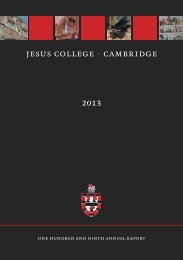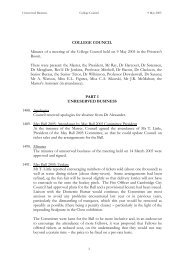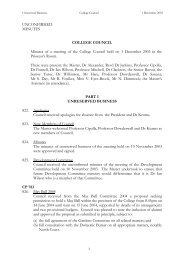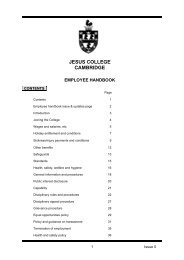2012 Annual Report - Jesus College - University of Cambridge
2012 Annual Report - Jesus College - University of Cambridge
2012 Annual Report - Jesus College - University of Cambridge
You also want an ePaper? Increase the reach of your titles
YUMPU automatically turns print PDFs into web optimized ePapers that Google loves.
ASTROPHYSICS I <strong>Jesus</strong> <strong>College</strong> <strong>Annual</strong> <strong>Report</strong> <strong>2012</strong> 19<br />
their galaxies being close together is <strong>of</strong>ten very large. Numerical computer simulations<br />
which compute the detailed mutual gravitational orbits <strong>of</strong> galaxies in our expanding<br />
universe can reproduce some <strong>of</strong> this clustering, but that is not the same as a more<br />
fundamental general theory <strong>of</strong> clustering.<br />
One <strong>of</strong> the things that my collaborators and I have been doing in the last two decades<br />
is developing such a fundamental theory. We do this by combining gravity with statistical<br />
mechanics and thermodynamics, theories describing properties <strong>of</strong> matter microscopically<br />
and in bulk. Originally many astronomers thought this combination would be impossible<br />
because gravity is a long range force which does not saturate and the combined forces <strong>of</strong><br />
many galaxies would be infinite in this approach. But we found that the expansion <strong>of</strong> the<br />
universe can remove these infinities and give a well-defined finite result. When the theory<br />
was first developed, we were not certain it would work. So some colleagues from<br />
Kyoto <strong>University</strong> tested it with computer simulations <strong>of</strong> galaxy clustering. They found<br />
very encouraging agreement. To paraphrase Mark Twain, it gratified some people and<br />
astonished the rest.<br />
This suggested that we test its relevance to our universe by comparing its predictions<br />
directly with observations <strong>of</strong> galaxy clustering. Its most straightforward prediction,<br />
containing no free parameters or “fudge factors”, is the galaxy distribution function. This<br />
is a simple but very powerful statistic which quantitatively describes clusters, filaments,<br />
voids and neighbouring correlations <strong>of</strong> galaxies. One simply divides space into many<br />
separate volumes with a given size and shape, then counts the number <strong>of</strong> galaxies visible<br />
in each volume. Plotting the number <strong>of</strong> volumes having a given number <strong>of</strong> galaxies<br />
provides an observed histogram to compare with the theoretical prediction. Then one<br />
repeats the analysis for volumes <strong>of</strong> different sizes and shapes. As this was done for larger<br />
and larger catalogues <strong>of</strong> galaxies the agreement grew closer and closer. As the numbers <strong>of</strong><br />
galaxies in larger catalogues increase, their statistics become more accurate. The theory<br />
works for very strong, as well as for weak, clustering. In the past year we have been able to<br />
use recent catalogues <strong>of</strong> about 10 million galaxies, and their agreement with the theory is<br />
better than about two or three percent.<br />
This work has indeed been gratifying, and also fun. Over many years, it has been done<br />
by a small group <strong>of</strong> astrophysicists who have focused several areas <strong>of</strong> cosmology, general<br />
relativity, thermodynamics, statistical mechanics and observational astronomy on the<br />
understanding <strong>of</strong> large-scale structure in our universe. It is truly international, like much<br />
<strong>of</strong> modern science, with collaborators in many countries including the UK, the USA, India,<br />
Ireland, Italy, Germany, Japan, Singapore, and China. To range around the universe; it<br />
helps to range around the world. As we answer earlier questions, new ones arise to<br />
fascinate us even further. For example, the theory has also predicted the probability that a<br />
galaxy has a given velocity relative to the expansion <strong>of</strong> the universe. Observations <strong>of</strong> these<br />
velocities are not yet developed to the same extent as observations <strong>of</strong> galaxy positions, but<br />
their preliminary agreement with the theory is promising.<br />
Very recently we have found a way to understand the probability that a cluster <strong>of</strong> galaxies<br />
has a given shape. It seems unnecessary to hypothesize that observed filaments <strong>of</strong> galaxies<br />
arose in a mysterious quantum epoch <strong>of</strong> the very early universe. Rather, they began to form<br />
spontaneously by natural gravitational attraction one or two billion years after the<br />
big-bang. Details <strong>of</strong> their formation depend on the nature <strong>of</strong> dark matter and dark energy,<br />
two major components <strong>of</strong> the universe presently shrouded in mystery. Mysteries <strong>of</strong> our<br />
universe tend to be related, so our understanding <strong>of</strong> its large-scale structure may help<br />
clarify our universe ’s other properties and their origins. ■













